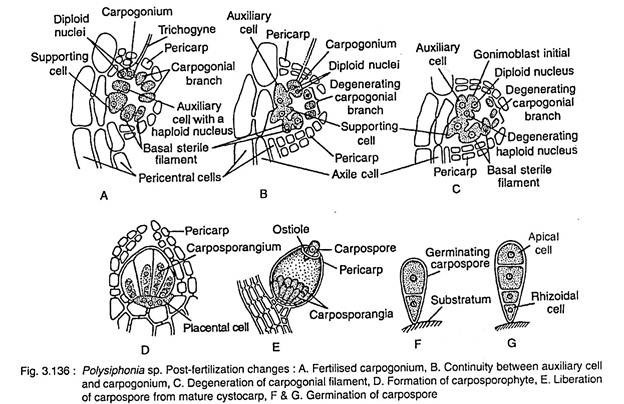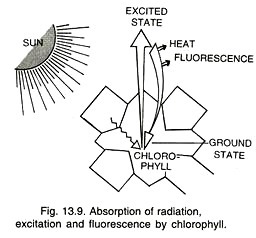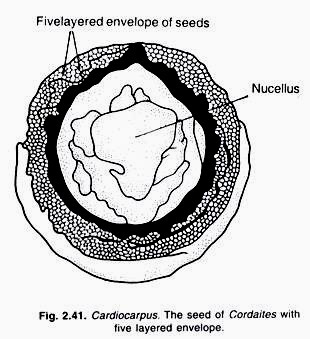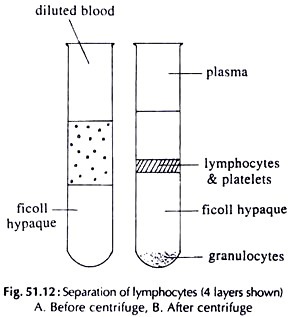Microtubules have many features that distinguish them from microfilaments and intermediate filaments.
To begin with, the outside diameter of a microtubule (usually about 25 nm) is much greater than that of microfilaments. Furthermore, microtubules are hollow, containing a central lumen about 15 nm in diameter.
Microtubule length is quite variable. Some microtubules are less than 200 nm long, but in the long processes of nerve cells their lengths may be as great as 25 μm (i.e., 25,000 nm). Microtubules can also be distinguished from microfilaments chemically. Microtubules contain two major proteins called a tubulin and β tubulin.
Each protein consists of a single polypeptide chain about 500 amino acids long (MW 55,000) and both are similar in primary structure, indicating that they are probably derived from a common ancestral protein. Not only are the α and β tubulins nearly identical but tubulins from diverse species of cells are very similar, suggesting either that they have hardly changed since they first appeared in eukaryotic organisms or that tubulin is a highly conserved protein.
α and β tubulin molecules combine to form heterodimers and these serve as the basic building blocks of microtubules. The model of heterodimer organization shown in Figure 23-14 is based on both chemical studies of microtubules and transmission electron microscopy. The microtubule is formed from a helical array of heterodimers with 13 subunits per turn of the helix. Neighboring heterodimers are linked to one another not only longitudinally but laterally as well.
Assembly and Functions of Microtubules:
The current model for the manner in which tubulin subunits are assembled into a microtubule is based on in vitro studies. Under carefully controlled conditions (e.g., the appropriate concentration of tubulin and the absence of calcium), alpha and beta subunits spontaneously form dimers that when present in high concentrations assemble into chains (Fig. 23-15); the chains then form a variety of intermediate structures including single and double rings, spirals, and stacked rings.
The rings eventually open up to form linear chains or proto-filaments that associate side-by-side to form sheets. When a sheet is sufficiently wide, it is curled to form a tube. The end result is the formation of short cylinders of dimers (Fig. 23-14). After a short cylinder is formed, continued growth occurs by the direct addition of more dimers. Growth occurs primarily by addition of dimers at one end of the tubule. It is believed that during certain micro-tubular functions (such as the operation of the anaphase spindle) the addition of dimers to one end of a microtubule is accompanied by the loss of dimers from the other end.
Assembly of tubulin into dimers requires that these polypeptides bind GTP. GTP-activated dimers can then combine with other dimers or with the growing microtubule. Attachment of a dimer to the microtubule is accompanied by the hydrolysis of the GTP, but the resulting GDP and phosphate remain bound to the tubule. The tubulin dimer also has sites that can bind the drugs colchicine, vincristine, and vinblastine (Fig. 23-16) and these substances inhibit microtubule assembly.
Tubules that are already present at the time of addition of these inhibitors disassemble. Calcium has long been recognized as an important ion in the microtubule assembly and disassembly process. Calcium may influence microtubules either directly or in association with the regulatory protein calmodulin. Recently, a number of proteins have been identified that associate with the surface of microtubules (Fig. 23-17); these proteins are called microtubule- associated proteins, or MAPs. Two families of MAPs have been separated by polyacrylamide gel electrophoresis: MAP-1 and MAP-2.
The MAPs facilitate microtubule assembly; that is, microtubules are formed considerably faster and at lower tubulin concentrations in the presence of MAPs. MAPs also protect microtubules from disassembly by colchicine and low temperatures. Interactions among microtubules and between microtubules and other cell components also involve MAPs. For example, microtubules may be interconnected via the micro-trabecular lattice; in these regions the lattice is rich in both MAP-1 and MAP-2. MAP-2 appears to be involved in cross-linking microfilaments and intermediate filaments with microtubules.
Although the extensive interactions between microtubules, cytoplasmic filaments, and the micro-trabecular lattice give support and shape to cells, microtubules play more than a supportive role for they are also intimately involved with cell motility, endocytosis and exocytosis, chromosome movements during mitosis, and the actions of cilia and flagella.
Centrioles:
Centrioles and basal bodies belong to a group of cell structures referred to as microtubule-organizing centers. These centers are involved in the elaboration of microtubules. Whereas the basal bodies are located at the bases of cilia and flagella, centrioles are usually found near the cell nucleus and occur in pairs; structurally, both organelles are identical.
The typical centriole is composed of nine sets of triplets, each triplet consisting of one complete microtubule and two incomplete, C-shaped ones. The triplets are arranged parallel to one another and create a cylindrical body having a diameter of 150 to 250 nm. Although rigorous proof is still lacking, it is generally believed that centrioles are involved in the production of the microtubules that form the spindle of a dividing cell. However, not all cells that form a spindle during nuclear division have centrioles; for example, cone-bearing and flowering plants do not.
In cells that do have paired centrioles, the centrioles separate at the onset of nuclear division and move to diametrically opposite positions around the nucleus. Subsequently, as the chromatin condenses to form chromosomes and the nuclear envelope disappears, fibers of the spindle make their appearance, extending from an area adjacent to one centriole through the cell to the other centriole (Fig. 23-18). As division proceeds, a new centriole appears near each original one; growth of the new centriole is always perpendicular to the long axis of the original centriole. By the time division is complete, each daughter cell has two complete centrioles.
Centrioles also play a role in the formation of the microtubules present, in flagella and cilia. Here the centrioles are more often referred to as basal bodies or kinetosomes (also blepharoplasts, basal granules, or basal corpuscles).
Structure of the Centriole:
Though not all cells contain centrioles, in those that do the structure of the centriole is the same. Most algal cells (but not red algae), moss cells, some fern cells, and most animal cells have centrioles, but cone-bearing and flowering plants, red algae, and some nonflagellated or nonciliated protozoans (like amoebae) do not. Some species of amoebae have a flagellated stage as well as an amoeboid stage; a centriole develops during the flagellated stage but disappears during the amoeboid stage.
The most notable structural characteristic of a centriole is its nine sets of triplets. Each triplet contains three microtubules, which in cross section appear to be arranged like the vanes on a “pinwheel” (Fig. 23- 19). Although there is no surrounding membrane, the nine triplets appear to be embedded in an electron- dense material.
The nine triplets are identical. The innermost (or a) microtubule of each triplet is a complete, round microtubule, but the middle (b) and outer (c) microtubules are incomplete, C-shaped, and share the wall of the neighboring microtubule. Also, the outermost (i.e., c) microtubules may not run the full length of the centriole. The triplets, although generally parallel to each other, may be closer together at the proximal end of the centriole (that end when observed “end-on” that has the triplets tilted inward in a clockwise direction, as shown in Fig. 23-19).
The triplets may also spiral somewhat about the central axis of the centriole. Strands of material extend inward from each a tubule and join together at the central hub. These strands, when seen in cross section, give the centriole the appearance of a cartwheel (Fig. 23-19b).
The idea prevalent years ago that new centrioles arise by the division of existing centrioles is no longer accepted. Rather it appears that new centrioles are either produced de novo or are synthesized using an existing centriole as some form of template. In the latter case, growth of the new centriole occurs at right angles to the long axis of the existing centriole, the two organelles separated from each other by a distance of 50 to 100 nm.
Basal body (i.e., centriole) development has been studied in the ciliates Paramecium and Tetrahymena and in tracheal epithelium of Xenopus and chicks. The stages of development are virtually the same in all of these. Development of the basal body begins with the formation of a single microtubule in an amorphous mass.
Microtubules are added one at time until there is an equally spaced ring of nine (Fig. 23-20). As the microtubules appear the amorphous mass is lost, as though it were being consumed in the production of the microtubules. There is some evidence that “connectives” exist between the microtubules, which could act to set the distance between them.
Each of the nine microtubules in the ring is microtubules. The b microtubules develop next and, finally, the c microtubules. Before the microtubules reach the doublet stage, the cylinder is rarely longer than 70 nm, but after this stage, the microtubules elongate. At the same time, the hub and “cartwheel” are added in the center (Fig. 23-20b). The a-c links are not formed until the end of development.
Basal bodies act as organizing centers for the development of the microtubules of cilia and flagella. New basal bodies form adjacent to centrioles. While still not associated with a flagellum or cilium, the basal body is more properly called a centriole, but after it migrates to a position just underneath the plasma membrane and acts as a center for flagellum or cilium development, it is called a basal body. The synthetic functions of centrioles and basal bodies are not clear. It has been suggested that these bodies may contain DNA and carry out transcription, but so far only RNA has been reported to be present.
Cilia and Flagella:
Cilia and flagella are organelles that project from the surface of certain cells and beat back and forth or create a corkscrew action (Fig. 23-21). In many instances, ciliary or flagellar movements propel cells through their environment. In other cases, the cell remains stationary and the surrounding medium is moved past the cell by the beating of its cilia (as in the layer of epithelial cells that lines the trachea or the collar cells lining the internal chambers of sponges).
Cilia are generally shorter than flagella (i.e., 5-10 μm versus 150 μm or longer) and are present in far larger numbers per cell. Flagella usually occur alone or in small groups; occasionally they are present in large numbers, as in a few protozoa and the sperm cells of more advanced plants. The distinction between cilia and flagella is somewhat arbitrary, because other than differences in their lengths, the structure and action of cilia and flagella of eukaryotic cells are identical. (Bacterial flagella differ in structure and action; see below.)
A eukaryotic cilium or flagellurn is composed of three major parts: a central axoneme or shaft, the surrounding plasma membrane, and the interposed cytoplasmic matrix (Fig. 23-22). The axonemal elements of nearly all cilia and flagella (as well as the tails of sperm cells) contain the same “9 + 2” arrangement of microtubules. In the center of the axoneme are two singlet microtubules that run the length of the cilium (Fig. 23-23). Projections from the central microtubules occurring periodically along their length form what appears to be an enclosing sheath. Each of the central microtubules is composed of 13 proto-filaments.
Nine doublet microtubules surround the central sheath. One microtubule of each doublet (i.e., the A subfiber) is composed of 13 proto-filaments. The adjoining B sub-fiber is “incomplete,” consisting of 11 proto-filaments (Fig. 23-23). Radial spokes having a periodicity of 24, 32, and 40 nm extend from each Asubfiber inward to the central sheath (i.e., they occur at repeating 24-, 32-, and 40-nm intervals along the axoneme’s length). Adjacent doublets are joined by nexin or inter-doublet links; the nexin links have a periodicity of 86 nm.
Extending from each A subfiber are two dynein arms—an “outer” arm and an “inner” arm (see Fig. 23-23). Thin projections from the ends of the dynein arms touch the B sub-fibers of the neighboring doublets. The outer dynein arms occur with a periodicity of 24 nm, whereas the inner arms have a periodicity of 24, 32, and 40 nm (the same as the radial spokes).
The cross section of the cilium depicted in Figure 23-23 is at a level that includes radial spokes, nexin links, and both dynein arms. Each beat of a cilium or flagellum involves the same pattern of microtubule movement. The beat may be divided into two phases, the power or effective stroke and the recovery stroke (Fig. 23-24). The power stroke occurs in a single plane, but recovery may not occur in the same plane as the power stroke.
The sliding microtubule model of ciliary movement is accepted by most investigators. In this model, the doublet microtubules retain a constant length and slide past one another in such a manner as to produce localized bending of the cilium. This activity is powered by ATP hydrolysis and the outer and inner dynein arms have been shown to contain most of the cilium’s ATPase activity.
The localized bending takes the form of a wave that begins at one end of the organelle and proceeds toward the other (usually, but not always, from base to tip). The localized bending is produced through the cyclic formation and breakage of links between the dynein arms of one doublet and the neighboring doublet.
The protein filaments that make up each doublet are rows of tubulin molecules that apparently contain the sites to which the dynein binds. The fact that the sliding of microtubules past one another results in bending of the cilium may be explained by the behavior of the radial spokes that connect the outer nine doublets to the central sheath.
In straight regions of the axoneme, the radial spokes are aligned perpendicular to the doublets from which they arise, whereas in the bent regions they are tilted and stretched (Fig. 23-25). Firm attachment of the radial spokes at both ends provides the resistance necessary to translate the sliding of the doublets into a bending action. Indeed, if the radial spokes and nexin links of sperm tails are destroyed by exposure to trypsin, addition of ATP results in the axonemes becoming longer and thinner, for microtubule sliding is no longer resisted. In effect, sliding is uncoupled from bending by elimination of the connections between the doublets and the central sheath.
Analogies are evident between the dynein-tubulin system of cilia and flagella and the actin-myosin system of muscle. However, whereas muscle fibers can only shorten and relax, cilia are capable of a much larger variety of movements. Ciliary and flagellar activity can be in a single plane, in three-dimensional or helical strokes, and can move the cell forward or backward using waves that are propagated from base to tip or from tip to base.
At the chemical level, whereas Ca2+ appears to activate the actin-myosin system, these ions have the opposite effect on the dyneintubulin system. The regulation of the Ca2 + level in a cilium or flagellurn probably involves the plasma membrane surrounding the axoneme. Under normal circumstances (i.e., during periods of continuous beating), the internal Ca2+ level is low (about 0.1μm) whereas Mg2 + (necessary to stimulate the ATPase of the membrane) remains in the millimole range.
When the membrane is depolarized, the Ca2 + level inside the cilium increases and beating ceases. ATP is clearly the source of energy for movement and is produced by cellular respiration. In many cells, mitochondria are located adjacent to the basal body of the cilium or flagellurn, and ATP diffuses toward the tip of the organelle. In sperm, a large mitochondrion is an integral part of the tail (Fig. 23-26) and is wrapped in a spiral about the middle piece of the axoneme.
Bacterial Flagella:
Flagella of bacteria are different from cilia and flagella of eukaryotic cells. The bacterial flagellum is not covered by the plasma membrane rather it consists of a naked spiral filament about 13.5 nm in diameter and 10-15 nm long. The filament is composed of a chain of repeating protein subunits called flagellin. At its basal end, the spiral filament is attached to a “hook,” which in turn is connected to a rod that penetrates the bacterial cell wall and plasma membrane (Fig. 23-27). A number of rings connect the rod with the membrane and wall layers.
Bacterial flagella work by rotation of the rod and hook, which causes the filament to spin. When the filament spins in a counterclockwise direction, the cell is propelled smoothly and in a straight line, but when the spin is clockwise, a chaotic tumbling motion of the cell is observed.
A period of counterclockwise rotation is followed by a burst of clockwise rotation, so that the bacterium is continuously set off along new linear paths. The source of energy for the rotation (believed to be generated at the cell membrane) is an electrochemical gradient established by an electron transport system that acts across the plasma membrane.
The Mitotic Spindle:
Most studies of chromosome movement during mitosis have focused on the role played by the microtubules that make up the mitotic spindle fibers.
The spindle fibers cause three distinct chromosome movements during mitosis:
(1) orientation of sister chromatids,
(2) alignment of the centromeres on the metaphase plate, and
(3) separation of centromeres and movement of sister chromatids (segregation) to opposite poles of the spindle.
The microtubules that occur in the spindle include:
(1) The centromere microtubules, which terminate in a centromere;
(2) The polar microtubules, which terminate at the poles; and
(3) The free microtubules, which do not terminate in either a pole or a centromere.
All three types can be dissociated into tubulin subunits by colchicine or cold temperatures. Over the years, several models have been proposed to account for the movements of the chromosomes during anaphase. For example, it has been suggested that the chromosomes are “pushed apart by spindle fibers developing between centromeres that they are pulled apart by spindle fibers extending between the centromeres and the poles of the spindle, and that chromosomes migrate along spindle fibers.
Although individual spindle fibers do not stretch or contract per se, they do change in length through either addition or removal of subunits. S. Inoue has shown that free microtubules alternately grow and decrease in length. His in vitro studies indicate that the microtubules assemble at one end and disassemble at the other.
Other Cell Movements:
Regardless of whether the movements are “internal” (such as cyclosis in plant cells) or result in a major change in shape or position of the cell, the present evidence indicates that microfilaments and/or microtubules are fundamental to these activities. In most cases, an interaction between proteins—such as in the actin-myosin or dynein-tubulin systems—with the simultaneous involvement of an ATPase is the underlying biochemical phenomenon.













